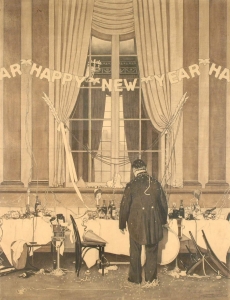
Norman Rockwell (1894–1978)|Happy New Year, 1945|Charcoal and ink on paper|Preliminary study for cover illustration for The Saturday Evening Post (December 19, 1945)|Norman Rockwell Museum Collection, NRM.1978.4
The task of composing the 1945 New Year’s cover of The Saturday Evening Post was delegated to artist Norman Rockwell. For a setting, he selected the fashionable Wedgwood Room of the Waldorf-Astoria hotel in New York City.* Having moved from its original location (now occupied by the Empire State Building), the Waldorf-Astoria had grown to become one of the most stylish hotels in America, and was the tallest structure of its kind in the world. Located on affluent Park Avenue, its guests included such luminaries as Winston Churchill, Clark Gable, and Lana Turner. By 1945 the hotel had already been made the subject of a popular film, Weekend at the Waldorf, starring Ginger Rogers and Van Johnson.** The Wedgwood Room, a supper club which was formally open in winter, ranked behind the Waldorf’s Sert Room in grandeur. However, with a capacity to seat 282 persons, the space drew many guests for dinner and evening entertainment, featuring performances by New Jersey singer Frank Sinatra, big bands, and others.*** The December 1945 New Year’s Eve celebration at the Wedgwood Room cost $24.20 per couple, with extra charges for beverages. Yet despite the price, which was comparatively high among similar establishments, the event was well-attended.****
To gather references for his New Year’s cover illustration, Rockwell traveled to the Waldorf from rural Arlington, Vermont, his hometown from 1939 until 1953. A New Yorker by birth, Rockwell enjoyed visiting the city to take in Broadway plays, and view the collections of the Metropolitan, the Frick, or the Museum of Modern Art. “The city moves too rapidly, it’s too chaotic, for

Happy New Year, 1945|Tear sheet of The Saturday Evening Post cover, December 19, 1945|Norman Rockwell Museum Archives
By tradition, New Year’s festivities have been celebrated with the convivial alcoholic drink. In Rockwell’s preparatory studies for his cover, champagne bottles and silver buckets are clearly visible. However, the final painting shows an abundance of confetti in place of these items. A letter from Post art editor, Ken Stuart, informed Rockwell that after a review of his oil study, it was decided that anything which alluded to the consumption of alcohol needed to be removed.****** Stuart was apologetic in his letter, and reminded Rockwell of a similar problem with a cover from the previous year, noting “You remember I had to take the beer our of the Arm Chair General’s glass and change it to milk or ginger ale or some such thing. I am against this procedure myself, as I think it lends an artificial or phony touch to leave things out that are part of the atmosphere.” These types of limitations remind us of the illustrator’s profession, an art form which often does not grant free creative expression. It is all the more interesting therefore, to observe how artists worked within the boundaries set by magazine editors, publishers, and advertising executives. The champagne bottles may have disappeared from Rockwell’s original cover concept, but how did those chairs fall over?
HAPPY NEW YEAR EVERYONE!
*”This week’s cover.” The Saturday Evening Post (1945, December 29): 2.
**”The Waldorf-Astoria: most famous U.S. hotel thrives on sumptuous efficiency.” Life 19 no. 15 (1945, October 8): 98-105.
***Jerry Franken, “Night club reviews: Wedgwood Room, Waldorf-Astoria, New York.” The Billboard (1950, February 18): 48. “Sinatra out of ‘gas’ in tunnel.” The New York Times (1945, December 4): 38. Retrieved from ProQuest Historical Newspapers, The New York Times (1851-2007). (Document ID: 103606106)
****”High prices are set for New Year’s Eve: Record number of reservations listed despite heaviest tarriffs in decade.” The New York Times (1945, December 28): 15. Retrieved from ProQuest Historical Newspapers, The New York Times (1851-2007). (Document ID: 109348937)
***** Mel Heimer, “My New York.” n.p. (c. 1949): n. pag. Copy in Norman Rockwell News Clippings, Norman Rockwell Museum Collection.
******Ken Stuart to Norman Rockwell, 15 October 1945. Norman Rockwell Collected Correspondence: Curtis Publishing Company. Norman Rockwell Museum Collection.
December 30, 2010
By Corry Kanzenberg, Curator of Archival Collections
Norman Rockwell Museum






